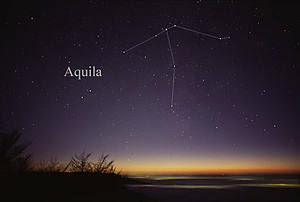In illustrations of Aquila that represent it as an eagle, a nearly straight line of three stars symbolizes part of the wings. The center and brightest of these three stars is Altair. The tips of the wings extend further to the southeast and northwest. The head of the eagle stretches off to the southwest.
According to Gavin White, the Babylonian Eagle carried the constellation called the Dead Man in its talons. The author also draws a comparison to the Classical stories of Antinous and Ganymede. In classical Greek mythology, Aquila was identified as Αετός Δίας (Aetos Dios), the eagle that carried the thunderbolts of Zeus and was sent by him to carry the shepherd boy Ganymede, whom he desired, to Mount Olympus; the constellation of Aquarius is sometimes identified with Ganymede. In the Chinese love story of Qi Xi, Niu Lang (Altair) and his two children (β and γ Aquilae) are separated forever from their wife and mother Zhi Nu (Vega) who is on the far side of the river, the Milky Way. In Hinduism, the constellation Aquila is identified with the half-eagle half-human deity Garuda.
In Chinese astronomy, ζ Aql is located within the Heavenly Market Enclosure (天市垣, Tiān Shì Yuán), and the other stars of the constellation are placed within the Black Tortoise of the North (北方玄武, Běi Fāng Xuán Wǔ). There were several different Polynesian equivalents to Aquila as a whole.
On the island of Futuna, it was called Kau-amonga, meaning "Suspended Burden". Its name references the Futunan name for Orion's belt and sword, Amonga. In Hawaii, Altair was called Humu, after the humu humu fish, and the whole constellation was called Humu-ma, the "Humu cluster". Humu-ma was said to influence the astrologers. Pao-toa was the name for the entire constellation in the Marquesas Islands; the name meant "Fatigued Warrior". There were also Polynesian constellations that incorporated the stars of modern Aquila. The Pukapuka constellation Tolu, meaning "three", was made up of Alpha, Beta, and Gamma Aquilae. Altair was commonly named among Polynesian peoples as well. The people of Hawaii called it Humu, the people of the Tuamotus called it Tukituki ("Pound with a hammer")- they named Beta Aquilae Nga Tangata ("The Men")- and the people of Pukapuka called Altair Turu and used it as a navigational star. The Maori people named Altair Poutu-te-rangi, "Pillar of the Sky", because of its important position in their cosmology. It was used differently in different Maori calendars, being the star of February and March in one version and March and April in the other. Altair was also the star that ruled the annual sweet potato harvest.
>> Ada banyak legenda yang berbicara tentang Aquila, salah satu legenda yang paling terkenal adalah legenda dari China yang mengisahkan kisah cinta Qi Xi, Niu Lang dan dua orang anaknya, yang terpisah selamanya dari Istri dan ibu mereka, Zhi Nu (legenda ini mirip dengan legenda dari Jepang yang mengisahkan tentang terpisahnya dua orang kekasih karena sungai galaksi dan hanya dapat bertemu dalam waktu tertentu, nama pasangan kekasih itu adalah Altair dan Vega dan terpisahkan oleh Milky Way. Sejak saat ini orang Jepang memperingati pertemuan dua kekasih ini dengan upacara Tanabata).
Aquila sendiri di identifikasikan sebagai elang yang membawa petir Zeus yang di kirim olehnya untuk membawa anak gembala ganymede yang dia inginkan ke gunung olimpus.
Source : http://en.wikipedia.org/wiki/Aquila_(constellation)
-------
L.N
Sept 1st, 2014


No comments:
Post a Comment